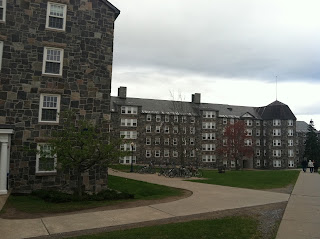As a recent Master's Degree graduate, I'd like to share
some tips for students headed off to graduate school or even just considering
it.
 1. Be prepared to not have a free moment. Working and going to graduate school part-time evenings and
weekends is nothing like your undergraduate experience. You have to really want
this and be truly dedicated. It's incredibly hard to manage your work life,
school work, and personal life. Know what you're getting yourself into and make
sure that this is 100% what you want to do.
1. Be prepared to not have a free moment. Working and going to graduate school part-time evenings and
weekends is nothing like your undergraduate experience. You have to really want
this and be truly dedicated. It's incredibly hard to manage your work life,
school work, and personal life. Know what you're getting yourself into and make
sure that this is 100% what you want to do.
2. Join
professional associations and organizations within your field
3. Make friends in your program – these are your future colleagues and professionals in the
field. Once you’re employed after you graduate, it’s also great to have
someone to bounce ideas off of other than a supervisor or boss – get their
contact information and stay connected after graduation. Also, depending
on your field of study, some programs are more project based with more group
work than others. It can be difficult to engage in group work now that
you’re probably not living on campus or connected with many other students.
4. Be involved in class and develop positive
relationships with your professors.
Your professors, much like your classmates, are your future colleagues and
you’ll probably be asking them for letters of reference upon graduation.
They may also have an in somewhere once you’re looking for jobs.
5. Complete an internship. Many Master’s level programs require it. If
they don’t, make sure you are either working in your field already or have some
kind of internship experience, whether it’s paid or unpaid (paid is preferred
but be prepared for something unpaid, as most are). You’ll need to get
your foot in the door somewhere and have some kind of experience on your resume.
6. Make sure that this is what you truly want to do. This is a huge commitment, so make sure you at
least work in the field first and understand what being a professional in this
specific industry means. Don’t invest all the time, money, and energy
into something unless you really know this is for you.
7. Choose a college for the quality of the program,
not for brand name. You are most
likely paying for this college experience on your own with no help from your
parents. Now is not the time to acquire tens of thousands of dollars of
debt. Even better, try to find a job in your field of study where your
employer has tuition reimbursement options available and will help you pay for
your schooling.
8. Understand that it may take more than 1-2 years to
complete your program. Some programs
will advertise that they are 1 or 2 year programs, but be careful. They are
probably assuming you will go full-time (including summers) and are not
including any kind of internship or practicum requirements in that time frame.
For example, I was told my program was a 2 year program and it ended up taking
me 4 years to complete it. If you are working full-time and only taking classes
part-time in the evenings and weekends, it will take you longer than someone
who can take 3-4 classes at a time because they are only working part-time or
are unemployed.
Ultimately, graduate school is a huge investment of time,
money, and energy. Be well informed and do your research! Please
share any additional tips you have!
About Smart Track™ Toolkit: The toolkit is a
web based service that assists families with everything from admissions and
test prep, to student athletics and financial aid. Our intuitive software and
on-demand workshops are key components to making sure students find their top
choice colleges, and families can afford to send them there.
About the author: Laura
Guarino Boston College
Connect with us






